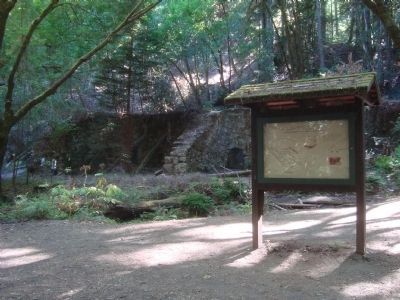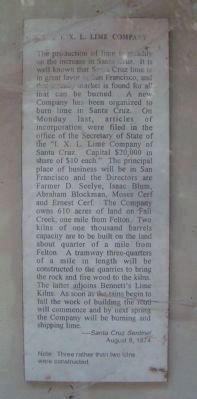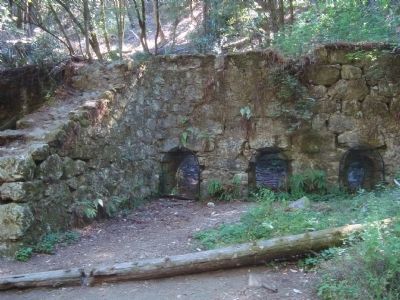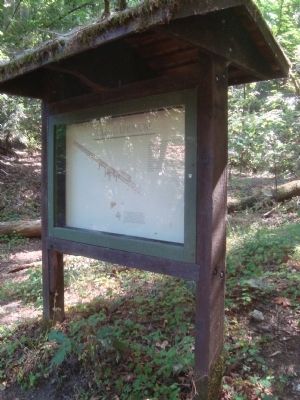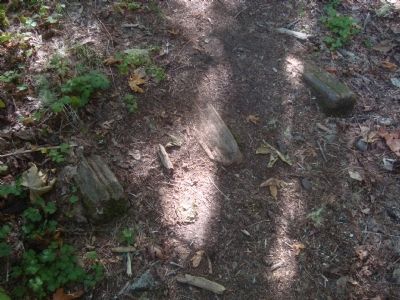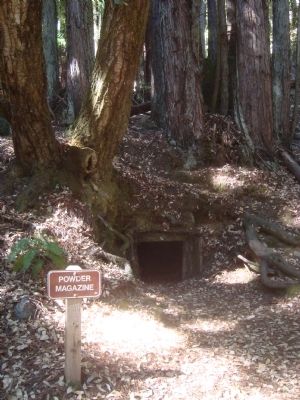Felton in Santa Cruz County, California — The American West (Pacific Coastal)
Historic Lime Kilns
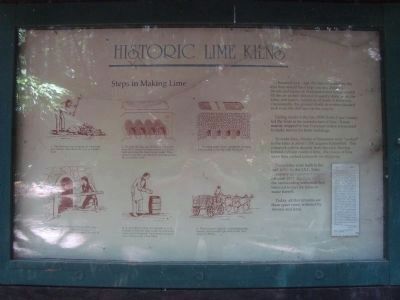
Photographed By Barry Swackhamer, August 19, 2012
1. Historic Lime Kilns Marker
2. To load the kiln, the chunks of limestone were first stacked to form and arch 4 to 5 feet high and from the front to the rear walls. These created chambers for the fuel and supported the rest of the load.
3. After the arches were completed, the kiln was stacked to the top with limestone.
4. Two men, working 12-hour shifts, kept the fire going 24 hours per day for 3 or 4 days. A single firing consumed 20 cords of redwood.
5. It took about 2 days for the kiln to cool enough so that the lime could be unloaded and packed in barrels.
6. Horse-drawn wagons, each holding fifty barrels, delivered the product to the train depot in Felton.
During much of the late 1800s Santa Cruz County led the State in the manufacture of lime. It was mainly shipped to San Francisco where it was used to make mortar for brick buildings.
To make lime, chunks of limestone were “cooked” in kilns at about 1,700 degrees Fahrenheit. This removed carbon dioxide from the rock, leaving behind calcium oxide or lime. The pieces of lime were then packed in barrels for shipping.
These kilns were built in the mid 1870s by I.X.L. Lime Company and operated on and off until 1919. By then, most of the surrounding redwoods has been cut to fuel the kilns or make barrels.
Topics. This historical marker is listed in this topic list: Industry & Commerce. A significant historical year for this entry is 1919.
Location. 37° 3.506′ N, 122° 5.742′ W. Marker is in Felton, California, in Santa Cruz County. This marker is in the Fall Creek unit of Henry Cowell Redwoods State Park. The lime kilns are located at the junction of South Fork, Cape Horn and Kiln Trails. The trail head parking lot is at approximately 800 Empire Felton Road. The trail to the lime kilns is approximately 1 mile. Touch for map. Marker is in this post office area: Felton CA 95018, United States of America. Touch for directions.
Other nearby markers. At least 8 other markers are within 3 miles of this marker, measured as the crow flies. Felton Presbyterian Church (approx. 1.2 miles away); The Cremer House (approx. 1.3 miles away); Felton Covered Bridge (approx. 1˝ miles away); Roaring Camp Covered Bridge (approx. 2.1 miles away); Ben Lomond Library and Club House (approx. 2.1 miles away); Park Hall (approx. 2.1 miles away); St. Andrew’s Episcopal Church (approx. 2.1 miles away); Wagon Top Boiler (approx. 2.2 miles away). Touch for a list and map of all markers in Felton.
Additional commentary.
1. Text of Newspaper Article Displayed on the Historic Lime Kiln Marker - See Photo #3
I.X.L. Lime Company
The production of lime is steadily on the increase in Santa Cruz. It is well known that Santa Cruz lime is in great favor in San Francisco, and that a ready market is found for all that can be burned. A new Company has been organized to burn lime in Santa Cruz. On Monday last, articles of incorporation were filed in the office of the Secretary of State of the “I.X.L. Lime Company of Santa Cruz. Capital $20,000 in share of $10 each.” The principal place of business will be in San Francisco and the Directors are Farmer D. Seelye, Moses Cerf and Ernest Cerf. The Company owns 610 acres of land on Fall Creek, one mile from Felton. Two kilns of one thousand barrels capacity are to be built on the land about a quarter of a mile from Felton. A tramway three-quarters of a mile in length will be constructed to the quarries to bring rock and fire wood to the kilns. The latter adjoins Bennett's Lime Kilns. As soon as the rains begin to fall the work of building the road will commence and by next spring the Company will be burning and shipping lime.
---- Santa Cruz Sentinel
August 8, 1874
Note. Three rather than two kilns were constructed.
— Submitted September 5, 2012.
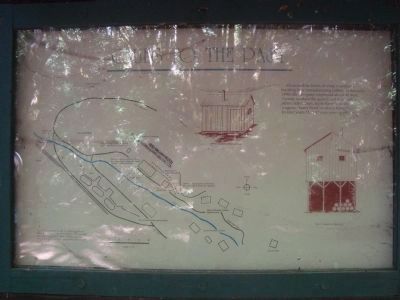
Photographed By Barry Swackhamer, August 19, 2012
4. Historic Lime Kilns Site Diagram
Clues to the Past
All around lie traces of what was once a bustling lime manufacturing center. In the early 1890s the company employed about 40 men. Twenty worked the quarry and kilns, while others felled trees, made barrels, or drove wagons. Many lived in cabins along the creek. In later years 15 to 17 men were employed. Each kiln produced up to 1,000 barrels of lime per firing. The use of three kilns made for more efficient use of labor. While one was being loaded, another was being fired, and a third was cooling.
[Click on image to enlarge]
All around lie traces of what was once a bustling lime manufacturing center. In the early 1890s the company employed about 40 men. Twenty worked the quarry and kilns, while others felled trees, made barrels, or drove wagons. Many lived in cabins along the creek. In later years 15 to 17 men were employed. Each kiln produced up to 1,000 barrels of lime per firing. The use of three kilns made for more efficient use of labor. While one was being loaded, another was being fired, and a third was cooling.
[Click on image to enlarge]
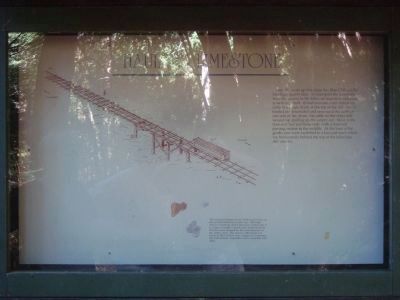
Photographed By Barry Swackhamer, August 19, 2012
8. Hauling Limestone Marker
Just 300 yards up this slope lies Blue Cliff – a 150 foot high quarry face. To transport the limestone from the quarry to the kilns, an ingenious tramway system was built. It had two cars, each linked via cable to a single drum at the top of the hill. As the loaded car descended, and unwound the cable on one side of the drum, the cable on the other side wound up, pulling up the empty car. Most of the tramway had just three rails, with a four-rail passing section in the middle. At the base of the grade, cars were switched to a two-rail track which ran horizontally behind the top of the kilns (ties still visible).
The limestone formed from shells layed [sic] down on the seafloor millions of years ago. Although almost everybody calls it limestone, technically it is a type of marble – rock formed from limestone that has been changed by heat and pressure in the earth’s crust. This process obliterated any traces of the fossils it once contained. Sometimes the rock included impurities such as graphite and silica.
The limestone formed from shells layed [sic] down on the seafloor millions of years ago. Although almost everybody calls it limestone, technically it is a type of marble – rock formed from limestone that has been changed by heat and pressure in the earth’s crust. This process obliterated any traces of the fossils it once contained. Sometimes the rock included impurities such as graphite and silica.
Credits. This page was last revised on January 31, 2021. It was originally submitted on August 31, 2012, by Barry Swackhamer of Brentwood, California. This page has been viewed 1,289 times since then and 85 times this year. Photos: 1, 2, 3, 4, 5, 6, 7, 8, 9, 10. submitted on August 31, 2012, by Barry Swackhamer of Brentwood, California. • Syd Whittle was the editor who published this page.
